
New!

Space Age Design
Midcentury Futuristic Atomic Googie Jet Age
World's Fairs
1962 Seattle & 1964 New York City
World's Fairs had a long history of looking into the future and demonstrating cutting edge technology. The 1893 Chicago World's Fair displayed electricity and electric lighting on a larger scale than ever seen before. The theme of the 1933/1934 Chicago World's Fair was technological innovation. It featured "The Homes of Tomorrow", numerous car prototypes, and the modernist art deco architecture. The New York World's Fair of 1939-1940 was the first exposition to be based on the future, with an opening slogan of "Dawn of a New Day". It allowed all visitors to take a look at "the world of tomorrow".
The 1962 Seattle and 1964 New York Worlds Fairs were loaded with midcentury futuristic architecture and themes. The architecture was futurism on steroids, often impracticle or not economically viable in the real world. It was also mostly temporary as most was torn down after the fairs ended.
1964 New York World's Fair
The 1964/1965 New York World's Fair took place at the very end of the Space Age era. It ran for two six month seasons, April 22-October 18, 1964 and April 21-October 17, 1965. The fair's theme was "Peace Through Understanding", dedicated to "Man's Achievement on a Shrinking Globe in an Expanding Universe". This theme was represented by a 12 story high, stainless steel globe called the Unisphere. The fair covered 650 acres and had 168 pavilions.
The fair is best remembered as a showcase of the mid-20th century American culture and technology. The Bureau of International Expositions (BIE) did not recognize the fair. As a result, nations such as Canada, Australia, most of the major European nations and the Soviet Union, did not participate. This turned out to be a blessing. American companies picked up the slack and dominated the exposition as exhibitors. In fact, close to two thirds of the grounds were exhibitions by individual companies. The corporations and some international and State governments mostly used futuristic architecture. Corporations embraced this design as it was more commercial and attention grabbing than traditional and other midcentury design. The result was a fair unlike no other and a feast ofr the eyes.
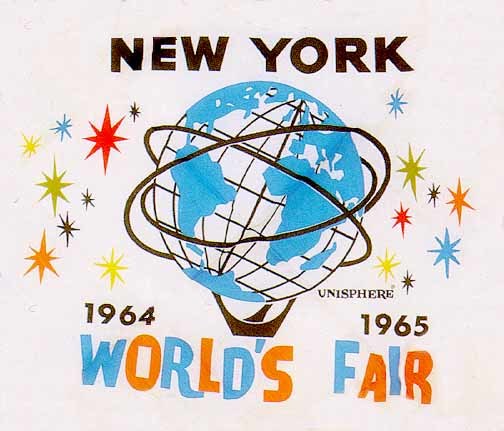
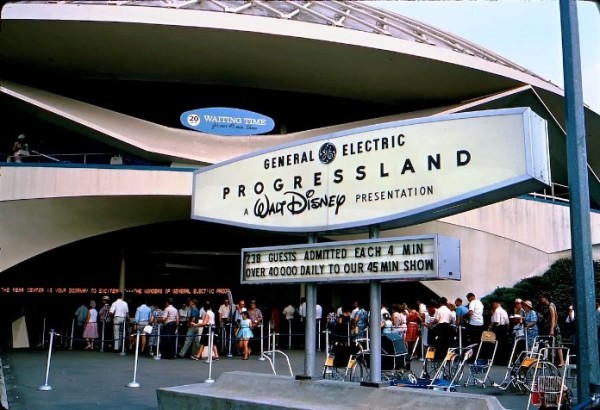
The architecture picked up where the 1962 Seattle World's Fair left off. It took futuristic design to an extreme that has never been repeated. It was futuristic design on steroids. Some pavilions were explicitly shaped like the product they were promoting, such as the US Royal Tire shaped Ferris wheel. Others were shaped like the corporate logo, such as the Johnson Wax pavilion. Other pavilions were more abstract such as the IBM pavilion or the General Electric dome shaped "Carousel of Progress". The pavilions used new building materials and methods such as reinforced concrete, fiberglass, tempered glass and stainless steel. The facade or the entire structure of a pavilion served as a giant billboard advertising the country or organization housed inside, flamboyantly competing for the attention of fairgoers.
GE / Disney Presentation
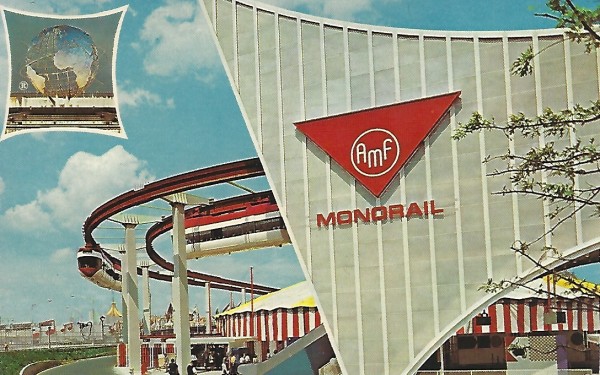
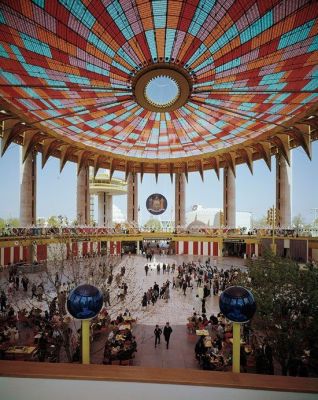
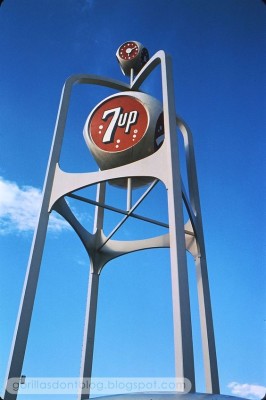
7up Sign
New York State Pavilion
Monorail
The Fair became an exhibition of American corporations look forward to the future. Many of the largest American manufacturing companies had a major presence. It gave many attendees their first interaction with computer equipment. Some corporations demonstrated the use of mainframe computers, computer terminals with keyboards and CRT displays, Teletype machines and telephone modems in an era when computer equipment was kept in back offices away from the public. This was decades before the internet, home computers or smart phones were at everyone's displosal. Futuristic experiences included the General Motors Futurama Ride, the helicopter landing on the rooftop of the Port Authority Building, homes of the future, the Swiss Sky Ride, From Drumbeat to Telstar in a Moving Chair, a display of synchronized water, fireworks, color and animations, and a Monorail. According to the Official Souvenir book, it also included "many fantastic glimpses into the future which will become reality to the eager, questioning minds of today."
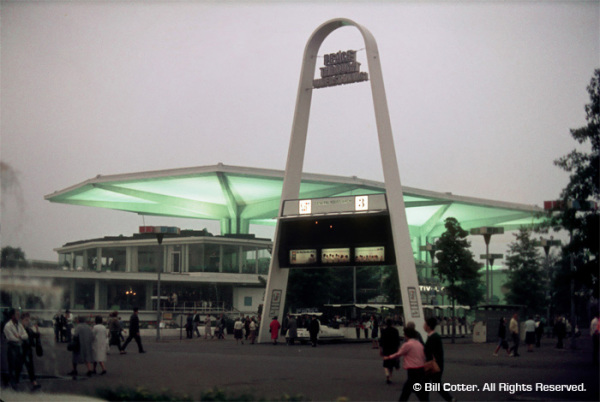
General Foods Arch in front of the Gas Pavilion

The General Motors exhibit was titled Futurama. Visitors were seated in moving chairs gliding past elaborately detailed miniature 3D model scenery showing what life might be like in the new future. It featured a trip to the moon, Antartica, an underwater hotel, a factory on wheels, seawater processed to irrigate deserts, the city of the future, and covered moving walks. It proved to be the Fair's most popular exhibit. Nearly 26 million people took the journey into the future during the Fair's two years. Part of the script was "Never has the world held a brighter promise of things to come."

Underwater colony at GM's Futurama exhibit.

GM's City of the Future from its Futurama exhibit.
The IBM Corporation had a popular pavilion which covered 54,038 square feet (1.2 acres). Designed by Charles Eames and Eero Saarinen Associates, the pavilion created the effect of a covered garden, with all exhibits in the open. A giant 500-seat grandstand called the "People Wall" was pushed by hydraulic rams high up into an ellipsoidal theater designed by Eero Saarinen. There, a film by Charles and Ray Eames titled Think was shown on fourteen large and eight small screens, illuminating the workings of computer logic. People could give a computer a historic date and it would give the important events that happened that day. For many visitors, this was their first hands-on interaction with a computer.
GM Pavilion

Ford Motor Company introduced its Ford Mustang automobile to the public at its pavilion on April 17, 1964. On the upper level was "Ford's Magic Skyway" ride, in which guests rode in Ford vehicles past scenes featuring dinosaurs and cavemen. It then entered the Space Age on a superskyway over a City of Tomorrow with towering metal spires and the glittering glass of bubble dome buildings. The animated scenes used Walt Disney’s new technique, audio animatronics. It was a combination of electromechanical actuators and computers controlling the movement of lifelike robots to act out scenes. The ride was described as a bridge between the past and the future. On the lower level the Ford Pavillion featured “gardens” that were designed by Walt Disney and showed scenes from around the world.
IBM Pavilion


Ford Ride

Ford Mustang Debut Presentation
General Electric sponsored "Progressland", where an audience seated in a 250 seat auditorium (the "Carousel of Progress") were carried past stages where animated human figures presented the story of electricity. A projection on the interior of the dome showed fierce electrical storms, fire, a blazing sun, and thousands of spinning atoms. The highlight was a loud demonstration of nuclear fusion.
GE PAvilion

Perhaps no other structure at the Fair exemplified futuristic design better than the Bell System's Floating Wing Pavilion. The upper story of the pavilion, which housed the ride, was a gigantic "floating wing" that rested on four pylons. Nearby rose a 140-foot microwave tower which transmitted TV shows originating at the Fair. The ride titled From Drumbeat to Telstar was one of the most complex and interesting film experiences of the Fair. The 1,000 moving armchairs with built-in speakers in two continuous loops of 500 each on two levels carried spectators through a 15-minute program which involved 65 motion pictures on individual screens.
Bell Pavilion
National Cash Register demonstrated “tomorrows world of automation”. It exhibited supermarket cash registers that dispensed both change and trading stamps, a computer-cash register system that tells the storekeeper how he is doing compared with a month or a year ago, and a fully automated branch bank system. A display of miniaturization offered such diminutive surprises as the King James version of the Bible on a single card, a sharp television image one eighth of an inch square and computer electronic circuits the size of a fly. The latter was a particularly accurate depiction of the future.
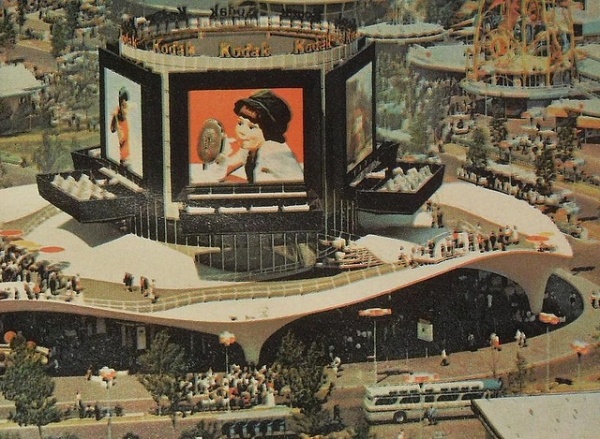
The Transportation and Travel Pavilion had a 96 foot high Moon Dome with an accurate relief map of the moon. Inside the dome you could view the film From Space to the Atom on a screen which encircled the audience. Outside, the Dancing Waters was music set to a changing pattern of multi-colored fountains. Kodak presented the Picture Tower, described as using Space Age technology to make the giant prints on their tower resemble glowing transparencies, even when the sun was shining directly on them. RCA exhibited a color television broadcast. Fairgoers could ride an Amphicar down a ramp and into a lake. Martin Marrieta’s presentation featured a rocket taking off into space bound for a space station floating above.
Kodak Pavilion

Government exhibits included a 2 acre United States Space Park sponsored by NASA, the Department of Defense and the fair. Exhibits included full scale models of the X-15 aircraft rocket powered research plane, a Gemini spacecraft, a used Mercury space capsule, an Apollo spacecraft, and a Lunar Excursion Module. It also included replicas of unmanned spacecraft and various satellites. States such as Florida, Alaska, Hawaii, Missouri, New Jersey, New England States, and West Virginia put up futuristic structures as elaborate as the major corporate buildings, though on a smaller scale. The Port of New York/New Jersey built a heliport. There was an exhibit area in the sky on four legs and a helicopter landing area on top.
Coca Cola Pavilion


Disney Pavillon

Port Authority Heliport
It wasn’t just American corporations and governments that used midcentury futuristic design. Many other nations put up pavilions that were generally less extreme versions of midcentury futuristic design. Religious organizations also put up futuristic buildings such as the Protestant Center, the Christian Science Pavillion, the Billy Graham Pavillion, and even the Vatican Pavillion.
The backers of the fair expected 70 million visitors. Instead only 50 million showed up and the fair lost significant money. The fair ended in controversy over allegations of financial mismanagement. While the 1939–1940 New York World's Fair returned 40 cents on the dollar to bond investors, the 1964/1965 fair returned only 19.2 cents on the dollar. Mistakes such as the lack of a midway and a hard to find amusement area contributed. The lack of an endorsement from the BIE led to less participation from foreign countries. No American world’s fair has since been built on a similar scale.
SC Johnson Wax Pavilion

Gas Pavilion with General Foods Arch in front

Schaefer Center
1962 Seattle World's Fair
The 1962 Seattle World's Fair (aka Century 21 Exposition) was similar to the New York World's Fair just on a smaller scale. Being in the same city as Boeing, the themes were space, science and the future. The architecture was often very space age. The highlight was the Space Needle, America's Space Age answer to the Eiffel Tower. This Fair was approved by the BIE so there were more countries but less commercial exhibits. The positive views of the future rooted in the 1950s and technology was a major theme. The Fair was open one year, from April 21 to October 21, 1962. The best known architecture is the Space Needle which still stands. Many other parts of the fair also survived, unlike at New York. The site is now called the Seattle Center and is still a major tourist attraction.
The Federal government had a large NASA exhibit including mockups of satellites and the Mercury capsule that carried Astronaut Alan Shephard. There was a "Spacearium" which seated 750 for a flight through the solar system, and then out to the Milky Way. The U.S. Science Exhibit included math, astronomy, atomic science and genetics.
The Washington State Coliseum was 160,000 square feet and held numerous futuristic exhibits. In the Treshhold and the Threat exhibit, fairgoers rode a "Bubbleator" into the land of tomorrow. There was an exhibit on future transportation including air cars on an electronically connected highway. It included an office of the future and a climate controled farm factory. A library of the future was contained in a Univac computer.
GM exhibited its Firebird II concept car (see concept cars section of this site). Ford had its own concept car, the Sattle-ite XXI, and a simulated space flight exhibit. Total attendence was about 10 million, and the fair was one of the few to make a profit.
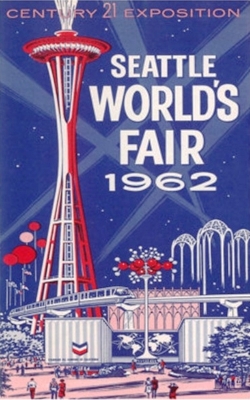
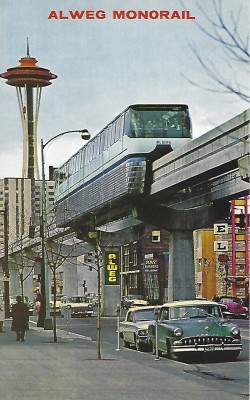
Brochure and monorail

Overhead view

Washington State Coliseum Cube Cloud


Overhead view
Paradise International on Show Street


Alaska Building
Bubbleator ride in the Washington State Coliseum


Canada Building
Christian Science Building


Monorail
U.S. Science Pavilion
1958 Brussels World's Fair
The 1958 World's Fair in Brussels, Belgium, was on a smaller scale than the two that followed in the U.S. Much of the architecture had a modern look, but it was more of a European modern. Sleek often boxy buildings (ala Mies Vander Rohe) along with some wild shapes and elements. European modern was more austere and less angular than Space Age. Most of the architecture was not Space Age but there was some of note. The key structure was the Atomium shown below. It represented the Atomic Age and was as identified with this fair as the Space Needle was later in Seattle.


The U.S. Pavilion. You could count on the Americans to do something Space Age.

The Atomium looked like an atom. Meant to be taken down after the Fair, it survives and has become a national symbol in Belgium.